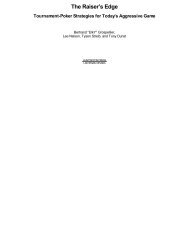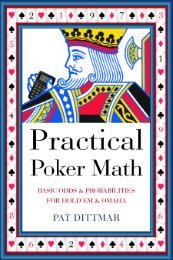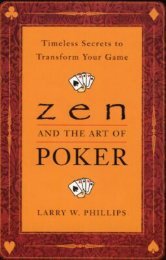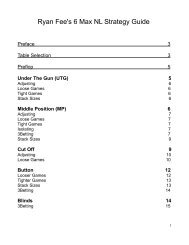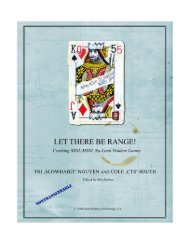Create successful ePaper yourself
Turn your PDF publications into a flip-book with our unique Google optimized e-Paper software.
There are three key variables when analyzing whether or not a<br />
semi-bluff shove is a good move.<br />
103<br />
1. The size of the pot in relation to the money left. The<br />
larger the stack to pot ratio, the more often he must<br />
fold. This is because we're proportionally risking more.<br />
2. How often he folds. Normally the smaller the stack to<br />
pot ratio, the less often he'll fold and vice versa. This is<br />
because our opponent is normally aware of the reward to<br />
risk ratio to some extent. 10<br />
3. Your showdown equity. The more showdown equity<br />
you have, the less often he'll have to fold.<br />
Now, I promised a shortcut, so here it is. We’re going to look at<br />
our reward to risk ratio in this shortcut.<br />
The pot is currently $39. We have to shove $27. Remember<br />
when we shove, we have equity. So, shoving isn’t risking $27 to<br />
win $39. We have to find out what we’re actually risking. Our<br />
shortcut has three steps.<br />
1. Total pot size times our equity.<br />
2. Subtract the result from step one from our bet.<br />
3. Examine the reward to risk ratio.<br />
Let's examine these three steps from our example.<br />
1. The final pot would be $81. Our equity against his all-in<br />
range is 24%. <strong>That</strong> would about $20. 11<br />
10 Even though they may not know the math, most people will be more<br />
cautious calling a large amount to win a small amount and vice versa.<br />
11 I would do this quickly by thinking of 80 divided by 4.





